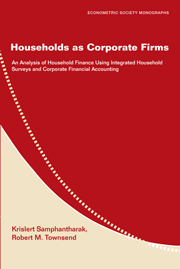 Households as Corporate Firms
Households as Corporate Firms 2 - Conceptual Framework
Published online by Cambridge University Press: 05 January 2013
Summary
The purpose of this monograph is to better measure productivity, liquidity, risk, financing, and portfolio management in an analysis of high frequency panel data. What emerges is an analogy between households and corporate firms. This chapter provides a conceptual framework that allows us to apply and modify the concepts in corporate financial accounting to the households from high frequency surveys in developing countries. We first argue for the analogy of households as corporate firms in section 2.1, and then provide the background on standard corporate financial accounting as well as discuss how conventional balance sheet, income statement, and statement of cash flows are related to household finance in section 2.2.
HOUSEHOLDS AS CORPORATE FIRMS: THE ANALOGY
Households in developing countries are not simply consumers supplying factor inputs and purchasing and consuming outputs. Many are also engaged in production in both farm and non-farm activities. In essence, these households function as firms. To understand this analogy, we discuss first in what business activities a typical firm is engaged. Then we present the analogy of households as corporate firms. This analogy serves as our conceptual framework when we construct household financial accounts later in this monograph.
Following Hart (1995), we define a firm as a collection of assets. In order to obtain these assets, a firm has to get the necessary financing. Two main sources of funds are the creditors and the owners. The owners of a firm are the shareholders.
- Type
- Chapter
- Information
- Households as Corporate FirmsAn Analysis of Household Finance Using Integrated Household Surveys and Corporate Financial Accounting, pp. 17 - 28Publisher: Cambridge University PressPrint publication year: 2009


